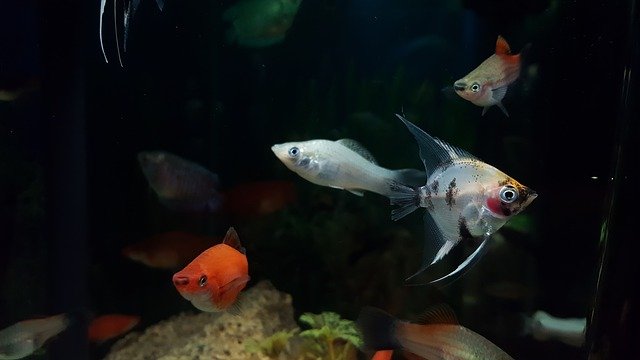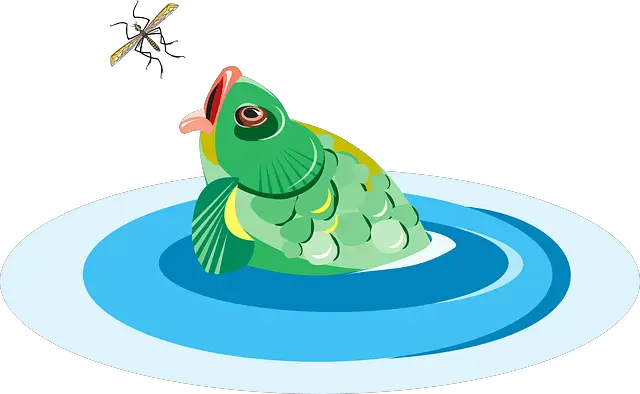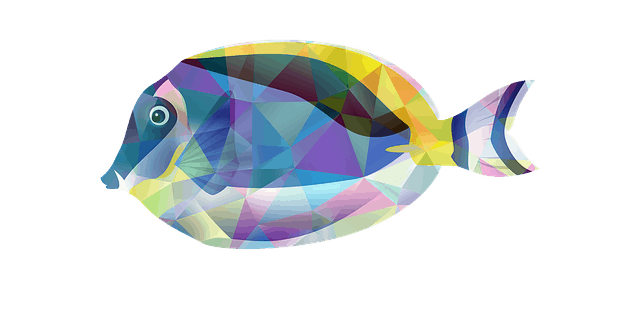Fish, as most aquarium hobbyists know, love to eat! They’ll often eat throughout the day until every last morsal of food is gone – regardless of whether they’re hungry or not. A common question relating to fish and their ability to eat when the lights go out includes ‘can aquarium fish see food in the darkness?’
The answer is yes, to a certain extent. While it’s true that all fish have some degree of night vision, most depend upon their sense of smell and/or sound to find food in the darkness. They also rely on their lateral line to detect pressure changes in the water.
Now that you know fish can see in the dark (somewhat), but that they often use their senses of smell and sound to find food in the absence of light, let’s explore this topic further. In this article, I’ll explain if fish like the dark, if they need darkness to survive, and what they usually do when the lights go out. I’ll also discuss the benefits of adding a night light to your fish tank and which type is a good one to buy.
So, if you’re ready to learn more about fish and their ability to find food in the dark, then let’s get started.
Do Fish Like the Dark?
Fish need darkness – that doesn’t necessarily mean they ‘like’ the dark. Darkness helps provide cover for skittish fish that tend to hide out. It also gives fish the opportunity to rest near the surface (or on the substrate, depending on the fish), which is something they don’t often do when it’s light.
Nocturnal aquarium fish, on the other hand, do like the dark and often become more active when the lights go out. Species include angelfish, damselfish, wrasses, puffers, and gobies. They have a highly developed lateral line that allows them to find food at night through changes in water movement.
Do Aquarium Fish Need Darkness?
All fish, whether living in an aquarium or in their natural habitat, need periods of darkness. To mimic the typical day-night cycle, it’s recommended that you leave the tank light on for 12 hours and then turn it off for 12 hours. The absence of light will give fish the chance to relax or ‘nap’ until the light returns.
If you don’t have an aquarium light, you can keep the tank near a window or under a lamp during the day and then cover it with a blanket at night. For the health of both the fish and the plants in the tank, try to stick to the ‘12 hours of light followed by 12 hours of darkness’ sequence as closely as possible.
Can Fish See Food in the Dark?
To find food in the darkness, fish rely on their senses of smell and sound along with whatever level of night vision they possess. Though it’s more difficult for them to eat without light, it’s still possible and does occur both in the wild and in captivity.
The Lateral Line System (or LLS) – which is a group of sensory organs that give fish the ability to detect movement or vibrations through pressure changes in the water- is also necessary for fish to be able to feed in the dark.
How Do Fish Find Food in the Dark?
Finding food in the dark is no easy feat for most fish. In the wild, they often adapt to their surroundings by using terminal rather than lateral vision. This means that their eyes face upwards instead of sideways, making it easier for them to see food silhouetted against the light reflecting off the surface of the water.
In an aquarium however, this adaptation doesn’t occur, so fish are forced to find food using their senses of sound and smell (instead of sight) in the darkness. Feeding aquarium fish at night is a waste, for the most part, as most of it just ends up uneaten on the substrate.
What Do Aquarium Fish Do at Night?
At night, most aquarium fish rest or ‘sleep’ by either hovering near the surface or laying motionless on the substrate. Darkness provides the chance for them to slow down their gill movements and regain much-needed energy. While at rest, they’re still highly alert and can easily detect movement in the tank.
Nocturnal aquarium fish, on the other hand, come to life in the darkness and become more active in cooler water temperatures. They may also feed more frequently and with greater success than other aquarium fish.
What Happens if You Leave a Fish in the Dark?
If you leave a fish in the dark for too long, it may lose its vibrant coloring over time. It may also become sluggish and/or skittish. It’s best to follow the natural day-night cycle of 12 hours of light followed by 12 hours of darkness.
Having a balance of both light and dark in an aquarium will provide fish with time to rest as well as prevent the overgrowth of algae in the tank, which can then lead to an increase in toxic bacteria. Too much light can be just as detrimental for fish as too much darkness.

Are Fish Scared of the Dark?
Aquarium fish may become skittish at the initial onset of darkness. The sudden transition from light to dark can cause them to hide or seek shelter among the plants or decorations in the tank. To reduce stress, try leaving the room light on for an additional 30 minutes after turning the aquarium light off.
Another option is to purchase and install an ambient blue light to make the natural transition from light to dark easier for your aquarium fish. I’ll explain more about the benefits of LED lighting as well as how it affects fish behavior (including feeding habits) in the subheadings to follow.
Can Fish Sleep with the Lights On?
Some aquarium fish will ‘sleep’ or rest throughout the day, regardless of whether it’s light or dark in the tank. Most fish, however, tend to follow the natural day-night cycle and are more active during the day while slowing down at night.
A blue ambient light is designed to simulate moonlight and is a great addition any tank. It won’t affect the day-night cycle of the fish nor will it increase water temperature or promote algae growth. If you have nocturnal fish, the blue light will help illuminate their movements and encourage activity.
Will a Blue Light Help Fish Find Food in the Dark?
A blue light may aid fish in finding food in the dark, however, it won’t help enough to make feeding them at night worthwhile. You can leave it on for a few hours after turning off the main aquarium light to help your fish transition easier from light to darkness, but don’t rely on it for feeding purposes.
Investing in a blue light is something any true aquarium hobbyist should consider. Not only do the fish like it, but they’ll also stay active longer – allowing you more time to enjoy viewing them. A great one to check out today and available online through Amazon is the Nicrew Classis LED Aquarium Light.
Conclusion
To conclude, while most fish can see in the dark to a certain degree, they tend to rely more on their senses of smell and sound to find food when the lights go out. They also depend upon their lateral line or sensory organs that work to detect changes in water pressure, signaling the presence of food.
Feeding your fish during the day is recommended as food is less likely to be wasted when there’s plenty of light to reveal it. An overabundance of uneaten food can cause a spike in dangerous ammonia and nitrite levels, ultimately affecting the health of your fish.
I trust this article has provided you with the information you seek. Thanks for reading and good luck with your aquarium hobby.
Related Posts
Do Aquarium Fish Need Darkness?
What Can You Feed Your Fish If You Have No Fish Food






